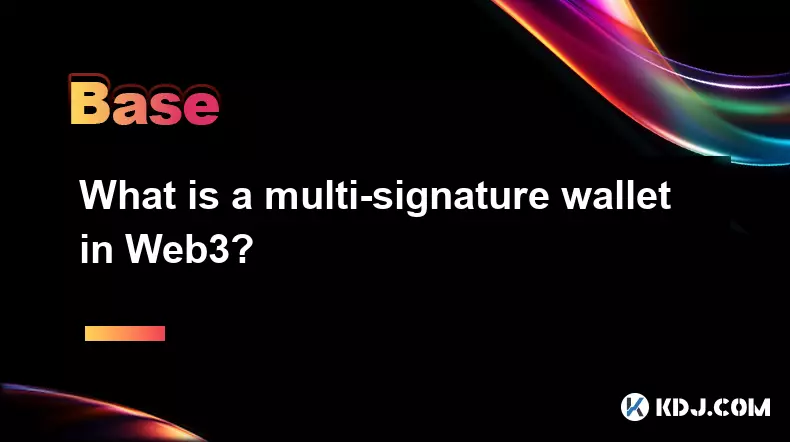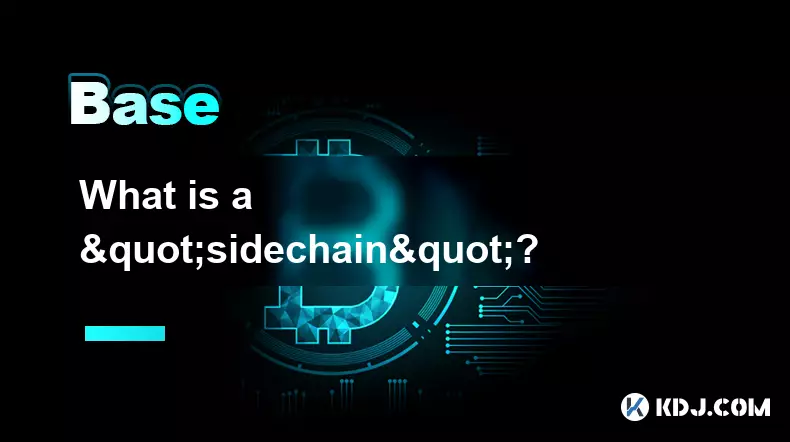-
 bitcoin
bitcoin $115692.075601 USD
5.13% -
 ethereum
ethereum $4162.931611 USD
11.68% -
 bnb
bnb $1310.063287 USD
17.56% -
 tether
tether $1.000983 USD
0.00% -
 xrp
xrp $2.534505 USD
8.16% -
 solana
solana $198.235737 USD
13.49% -
 usd-coin
usd-coin $1.000236 USD
0.02% -
 dogecoin
dogecoin $0.207352 USD
12.89% -
 tron
tron $0.323043 USD
3.62% -
 cardano
cardano $0.701559 USD
11.88% -
 hyperliquid
hyperliquid $39.924597 USD
8.30% -
 chainlink
chainlink $18.934457 USD
11.56% -
 ethena-usde
ethena-usde $1.000552 USD
0.02% -
 stellar
stellar $0.340575 USD
7.05% -
 bitcoin-cash
bitcoin-cash $545.011757 USD
8.86%
What is a multi-signature wallet in Web3?
Multi-signature wallets enhance security in Web3 by requiring multiple approvals for transactions, reducing single points of failure and enabling decentralized control.
Oct 12, 2025 at 07:55 pm

Understanding Multi-Signature Wallets in Web3
1. A multi-signature wallet, often referred to as a multisig wallet, is a type of cryptocurrency wallet that requires more than one private key to authorize a transaction. Unlike standard wallets where a single signature suffices, multisig wallets introduce an added layer of security by distributing control across multiple parties. This mechanism is especially valuable in decentralized environments where trustless coordination is essential.
2. These wallets are built on smart contract logic, allowing predefined rules for transaction validation. For example, a 2-of-3 multisig setup means that out of three authorized signers, at least two must approve any outgoing transaction. This configuration reduces the risk of fund loss due to theft or misplacement of a single key.
3. In Web3 applications, multisig wallets are commonly used by decentralized autonomous organizations (DAOs) to manage treasury funds. Since DAOs operate without centralized leadership, multisig structures ensure that no individual can unilaterally move assets, promoting transparency and collective decision-making.
4. They are also adopted by crypto startups and investment groups to secure pooled capital. By requiring consensus among team members or investors, these wallets prevent unilateral actions and enhance accountability in financial operations.
5. The underlying technology relies on elliptic curve cryptography and blockchain-native scripting capabilities. When a transaction is initiated, it remains pending until the required number of signatures is collected. Only then is it broadcast to the network for inclusion in a block.
Enhanced Security Through Distributed Control
1. One of the most significant advantages of multisig wallets is their resistance to single points of failure. If one private key is compromised, attackers still cannot access funds without the additional signatures.
2. Users can distribute keys across different devices, geographic locations, or trusted individuals. This diversification minimizes risks associated with hardware malfunctions, phishing attacks, or physical theft.
3. Institutional-grade custody solutions often integrate multisig frameworks to meet compliance and audit requirements. Financial entities leverage this model to enforce internal approval workflows before executing large transfers.
4. Recovery protocols can be embedded within multisig systems. For instance, if a key holder becomes unavailable, prearranged backup signers can step in, ensuring business continuity without sacrificing security.
5. Some implementations allow time-locked transactions alongside signature requirements, introducing delays that give participants a window to review and challenge suspicious activity.
Use Cases Across Decentralized Ecosystems
1. DAO treasuries frequently use multisig wallets managed by elected delegates. Proposals to spend funds are voted on off-chain or via governance tokens, and approved expenditures require cryptographic approval from designated members.
2. Escrow services in peer-to-peer trading benefit from 2-of-3 setups where the buyer, seller, and a neutral arbitrator each hold a key. Funds are released only when two parties agree, reducing fraud in trustless exchanges.
3. Smart contract developers deploy upgradeable protocols protected by multisig controllers. This allows critical fixes or feature additions while preventing unauthorized modifications to live code.
4. Crypto custodians implement multisig architectures for high-net-worth clients, combining biometric authentication, hardware security modules, and distributed signing nodes to safeguard digital assets.
5. Freelancers and remote teams use multisig wallets to manage shared project budgets. Payments to contributors are approved collectively, aligning financial actions with group consensus.
Challenges and Considerations
1. Setting up a multisig wallet demands technical understanding. Users must configure signing thresholds, register public keys, and securely store recovery materials—errors in setup can lead to irreversible fund loss.
2. Coordination overhead increases with the number of signers. Delays may occur if participants are unresponsive or lack compatible signing tools, impacting time-sensitive operations.
3. Not all blockchain networks support native multisig functionality. On platforms like Ethereum, such functionality is implemented through smart contracts, which incur gas fees for deployment and execution.
4. Social dynamics play a role in signer selection. Trust among participants is crucial; disputes over fund usage can stall decisions or lead to governance conflicts.
5. While highly secure, multisig wallets are not immune to collusion. If enough signers act maliciously or fall under coordinated attack, funds can still be drained despite the design safeguards.
Frequently Asked Questions
How does a multisig wallet differ from a regular crypto wallet?A regular wallet uses a single private key for transaction authorization, whereas a multisig wallet requires multiple signatures based on predefined rules. This distribution of signing authority enhances security and enables collaborative control over funds.
Can multisig wallets be used on any blockchain?Most major blockchains support multisig functionality either natively or through smart contracts. Ethereum, Bitcoin, and Polygon all enable multisig setups, though implementation methods and tooling vary across ecosystems.
What happens if a signer loses their private key?If a key is lost and the remaining signers cannot meet the threshold, funds may become inaccessible unless a recovery mechanism was established during setup. Proper backup strategies and contingency planning are essential for long-term usability.
Are multisig wallets suitable for individual users?Yes, individuals can benefit from multisig by using it as a personal security measure—such as requiring two out of three keys stored in separate locations. However, the complexity makes it more common among organizations and advanced users.
Disclaimer:info@kdj.com
The information provided is not trading advice. kdj.com does not assume any responsibility for any investments made based on the information provided in this article. Cryptocurrencies are highly volatile and it is highly recommended that you invest with caution after thorough research!
If you believe that the content used on this website infringes your copyright, please contact us immediately (info@kdj.com) and we will delete it promptly.
- XRP Price Prediction: Weekend Rollercoaster or Rally?
- 2025-10-12 08:45:16
- Bittensor (TAO): Super Bullish Signals Point to Potential 2x Rally
- 2025-10-11 10:25:12
- Silver Price Correction: Navigating the Dip & Identifying Key SEO Keywords
- 2025-10-11 10:25:12
- Decoding Crypto Trends: Bittensor's Bull Run, Cardano's Dip, and LivLive's Presale Buzz in 'Uptober 2025'
- 2025-10-12 08:45:16
- MoonBull: The Crypto Meme Coin Promising 1000x Gains?
- 2025-10-11 10:30:01
- Crypto Payroll Revolution: Stablecoins, Altcoins, and the Future of Salary Payments
- 2025-10-11 10:30:01
Related knowledge

What does it mean for code to be "open source" in crypto?
Oct 12,2025 at 01:54pm
Understanding Open Source in the Cryptocurrency Ecosystem1. In the context of cryptocurrency, open source refers to software whose code is publicly ac...

What is the purpose of a "testnet"?
Oct 12,2025 at 09:01am
Understanding the Role of Testnets in Blockchain Development1. A testnet serves as a parallel version of a blockchain network, designed specifically f...

How to avoid phishing scams in crypto?
Oct 13,2025 at 06:18pm
Understanding Common Crypto Phishing Tactics1. Cybercriminals frequently use fake websites that mirror legitimate crypto exchanges or wallet platforms...

What is the difference between single-collateral and multi-collateral Dai?
Oct 12,2025 at 05:18pm
Understanding Single-Collateral Dai1. Single-Collateral Dai (SCD) was the original version of the Dai stablecoin launched by MakerDAO in 2017. It allo...

What is a "sidechain"?
Oct 13,2025 at 02:36pm
Understanding the Concept of Sidechains1. A sidechain is a blockchain that operates independently but is connected to another blockchain, known as the...

What is "EIP-1559" and how did it change Ethereum?
Oct 12,2025 at 03:00am
Understanding EIP-1559 and Its Core Mechanism1. EIP-1559 is a protocol upgrade introduced to the Ethereum blockchain as part of the London hard fork i...

What does it mean for code to be "open source" in crypto?
Oct 12,2025 at 01:54pm
Understanding Open Source in the Cryptocurrency Ecosystem1. In the context of cryptocurrency, open source refers to software whose code is publicly ac...

What is the purpose of a "testnet"?
Oct 12,2025 at 09:01am
Understanding the Role of Testnets in Blockchain Development1. A testnet serves as a parallel version of a blockchain network, designed specifically f...

How to avoid phishing scams in crypto?
Oct 13,2025 at 06:18pm
Understanding Common Crypto Phishing Tactics1. Cybercriminals frequently use fake websites that mirror legitimate crypto exchanges or wallet platforms...

What is the difference between single-collateral and multi-collateral Dai?
Oct 12,2025 at 05:18pm
Understanding Single-Collateral Dai1. Single-Collateral Dai (SCD) was the original version of the Dai stablecoin launched by MakerDAO in 2017. It allo...

What is a "sidechain"?
Oct 13,2025 at 02:36pm
Understanding the Concept of Sidechains1. A sidechain is a blockchain that operates independently but is connected to another blockchain, known as the...

What is "EIP-1559" and how did it change Ethereum?
Oct 12,2025 at 03:00am
Understanding EIP-1559 and Its Core Mechanism1. EIP-1559 is a protocol upgrade introduced to the Ethereum blockchain as part of the London hard fork i...
See all articles























![[4K 60fps] Anyway by Retropt (1 Coin) [4K 60fps] Anyway by Retropt (1 Coin)](/uploads/2025/10/13/cryptocurrencies-news/videos/k-fps-retropt-coin/68ec4f42a41d0_image_500_375.webp)


















































